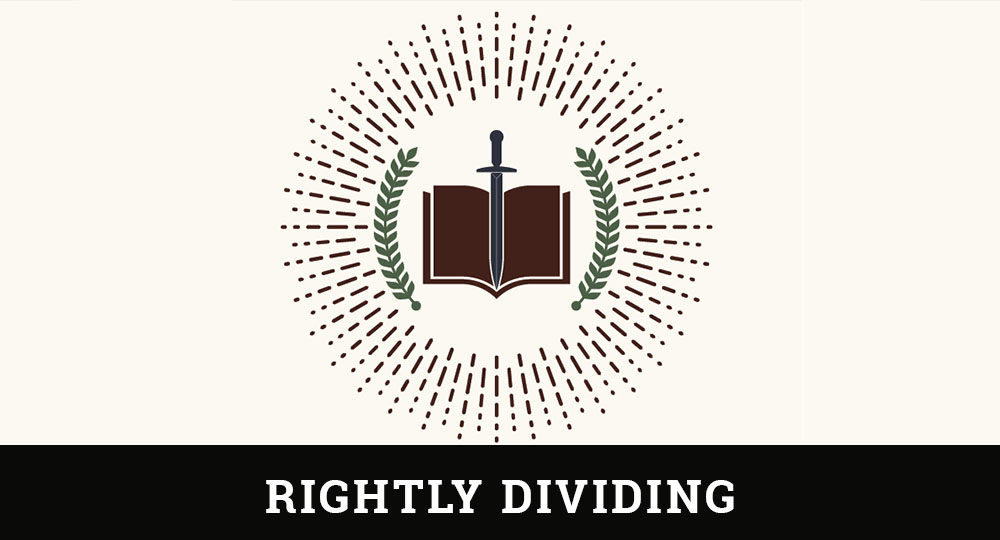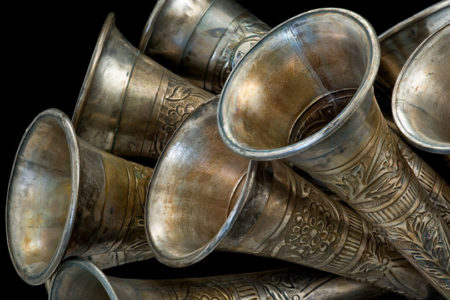Christ’s Superior Ministry Hebrews 9:11-22
Hebrews 9 begins with a description of the earthly Tabernacle and its ministry through the Levitical priesthood under the first (Mosaic) covenant. Both the Tabernacle and its services were temporary and functioned as an external figure (shadow) to represent spiritual truths pointing people to a new and superior program.
Since the sacrifices were powerless to take away sin, worshipers were continually plagued by a guilty conscience and lack of peace. A new, better program was needed because the Levitical system was insufficient and incapable of bringing the Israelites into a right standing before God. Therefore, God abolished the first covenant and replaced it with an eternal New Covenant implemented through Christ’s ministry.
Beginning with 9:9, the book of Hebrews explains the New Covenant’s power to remove an individual’s sin through Christ’s superior ministry.
Christ in a Superior Sanctuary
The phrase but Christ came as High Priest (v. 11) is the hinge upon which the argument swings as the author contrasted the old ministry under the Mosaic Covenant and the new ministry under Christ.
The focus is now on Christ’s heavenly ministry as “High Priest of the good things to come” (v. 11). These “good things to come” were what Christ accomplished through His more perfect ministry in the heavenly Tabernacle: (1) a better covenant, (2) the purging of a guilty conscience because of sin, (3) personal access and communion with God, and (4) prophetic blessings yet to come.
Christ’s ministry functions in a “greater and more perfect tabernacle not made with hands, that is, not of this creation” (v. 11). The Tabernacle Christ entered was not physical or created from earthly materials visible to the human eye. He entered the sanctuary of heaven itself to dwell and serve at the right hand of God the Father. Hebrews 8:2 calls Him “a Minister of the sanctuary and of the true tabernacle which the Lord erected, and not man.” Christ functions as High Priest in the very presence of God, making His ministry both effective and meritorious on behalf of mankind, whereas the Levitical system was not.
Christ’s Superior Sacrifice
“Not with the blood of goats and calves [bulls], but with [by] His own blood He entered the Most Holy Place [Holy of Holies] once for all, having obtained eternal redemption” (9:12). Christ’s shed blood is inestimably superior to the sacrificial blood of animals.
The contrast is between Christ entering by (or through) His own blood and the blood offered by Israel’s high priest on the Day of Atonement (Lev. 16). The Aaronic high priest entered the Holy of Holies to offer the blood of a bull for his own sins (v. 11), then he reentered with the blood of a goat for the sins of the people (v. 15). Christ, however, entered the Holy of Holies in heaven by means of His own blood for the sins of humanity.
Did Christ present His blood in heaven? The Greek text does not say He entered “with” (NKJV) His blood but “by” or “through” His blood—that is, by virtue of His atoning work at His death. He entered the heavenly sanctuary, not with literal blood, but with the blood-right atonement for mankind’s sins. Unlike the Levitical high priest who entered each year to offer animal blood, Christ entered once, there to remain as the Advocate for all believers.
Christ’s blood is effective because He is the sinless God-Man. It was His shed blood that made it possible for Him to enter the Holy of Holies as High Priest; and, on shedding His blood, He purchased and provided redemption for mankind.
Christ’s sacrifice was superior to the Levitical system in its sufficiency. He “entered the Most Holy Place [Holy of Holies] once for all, having obtained eternal redemption” (Heb. 9:12). The phrase having obtained eternal redemption has a twofold emphasis. First, the Aaronic high priest had to offer animal sacrifices annually on the Day of Atonement for his sins and those of the Israelites. If his offerings were sufficient to remove sin, they would not have been offered annually. In contrast, Christ’s once-for-all sacrifice was efficacious and sufficient to provide eternal redemption. He had no sin and, therefore, no need to offer sacrifice for Himself, but only for the people. His one-time sacrifice was sufficient for all who would ever live.
Second, this single act of sacrifice purchased “eternal redemption” for all people everywhere, doing away with the need for an annual atonement in an earthly Tabernacle by a sinful high priest for sinful mankind. However, though Christ’s sacrifice provided eternal redemption for all people, it is only efficacious for those who willingly receive Him.
Christ Secured a Superior Sanctification
The Levitical animal sacrifices—such as the sacrifice of “bulls and goats” and the “ashes of a heifer,” referring to the ordinance of the red heifer (v. 13; cf. Num. 19)—provided ceremonial cleansing or external purification for the nation of Israel (Heb. 9:13; cf. Lev. 16). These ceremonial cleansings merely purified “the flesh” (Heb. 9:13). If any priest touched a dead body or tomb, he was considered ceremonially unclean and could not enter the Tabernacle for service (Num. 19:13).
The word unclean refers to being unhallowed or profane and thus unfit for service. Priests could be brought back into fellowship only through “the blood of bulls and goats and the ashes of a heifer, sprinkling the unclean” (v. 13; cf. Lev. 16:3, 14–15; Num. 19:9–17). The blood of animals merely sanctified (set apart) the priest, making him externally pure and fit to serve in the Tabernacle.
For a man to be cleansed from a sin-ridden, guilty conscience would take much more than external cleansing via animal blood. It would take “the blood of Christ, who through the eternal Spirit offered Himself without spot to God” (Heb. 9:14). Only Christ’s shed blood on the cross is able to “cleanse [one’s] conscience from dead works to serve the living God” (v. 14).
A number of contrasts can be made between the two types of blood sacrifices.
- Animals themselves are under the sin curse (Gen. 3:14), so their blood can never provide internal cleansing from sin; but the blood of Christ can.
- If the blood of insensible animals, offered involuntarily, could cleanse the flesh from defilement, imagine how much more Christ’s blood, offered voluntarily, can cleanse from defilement.
- If beasts without merit (although qualified under Law to be offered for sin) could provide external cleansing, imagine how much more the sinless Christ (who offered Himself to God) can cleanse from sin.
- If the blood of animals purged the Israelites from ceremonial defilement, imagine how much more Christ’s blood can purge an individual’s conscience from dead works to serve the living God.
- No matter how meticulously the Levitical priests performed their duties, they always bore a sense of guilt and defilement; but in Christ, believers are liberated to experience perfect peace.
Christ’s Sacrifice Is Superior in Scope
Because of its nature and type, Christ’s blood sacrifice was superior to the animal sacrifices under the first covenant. Through His death, Christ became “the Mediator of the new covenant…for the redemption of the transgressions under the first covenant, that those who are called may receive the promise of the eternal inheritance” (Heb. 9:15). Through His death, Christ inaugurated a New Covenant that secured eternal redemption for all believers—those called under the first covenant, as well as those who, in the future, would believe.
The author drove home his point with an illustration: “For where there is a testament [covenant], there must also of necessity be the death of the testator” (v. 16). An inheritance can be acquired only upon the death of the one bequeathing it. The testament in this instance is a covenant that was inaugurated with the death of Christ, through His blood sacrifice on the cross. To activate the covenant, it was absolutely necessary for Christ to die, since He was the One inaugurating it.
Thus the New Covenant could legally take effect only on Christ’s death: “For a testament is in force after men are dead, since it has no power at all while the testator lives” (v. 17).
To prove the necessity of blood atonement, the author reminded those contemplating a return to Judaism that even the Mosaic (first) Covenant was inaugurated with blood:
Therefore not even the first covenant was dedicated without blood. For when Moses had spoken every precept to all the people according to the law, he took the blood of calves and goats, with water, scarlet wool, and hyssop, and sprinkled both the book itself and all the people, saying, “This is the blood of the covenant which God has commanded you.” Then likewise he sprinkled with blood both the tabernacle and all the vessels of the ministry (vv. 18–21).
Even the first covenant did not become effective until Moses read it to the people, who agreed to keep its precepts (Ex. 24:3–8). Then Moses sprinkled the book (covenant), people, Tabernacle, and vessels of ministry with blood and water. To become binding, the covenant needed to be ratified by blood because “according to the law almost all things are purified with blood, and without shedding of blood there is no remission [forgiveness of sin]” (Heb. 9:22).
In like manner, Christ has provided for the removal of sin through a New Covenant that He ratified by voluntarily offering, not the blood of animals, but His own uncorrupted blood. He confirmed this truth when, at His final Passover, He declared, “For this is My blood of the new covenant, which is shed for many for the remission of sins” (Mt. 26:28). Therefore, the New Covenant is eternal and unchangeable and provides eternal redemption because it was ratified by Christ alone, who is eternal.
What a wonderful and superior plan God inaugurated through Christ’s shed blood for our eternal redemption!







